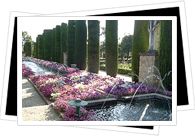 Built by King Alfonso XI in 1328, the Alcazar de los Reyes Cristianos was where kings and queens held court for around 160 years. Its name is taken from the two Christian Monarchs – Ferdinand II of Aragon and Isabella of Castile. King Ferdinand II and Queen Isabela frequently held court here. This is also where Christopher Columbus presented his plan to explore the westbound route to India to King Ferdinand and Queen Isabella. The Alcazar was used as a military and civil jail, particularly during the Inquisition.
Built by King Alfonso XI in 1328, the Alcazar de los Reyes Cristianos was where kings and queens held court for around 160 years. Its name is taken from the two Christian Monarchs – Ferdinand II of Aragon and Isabella of Castile. King Ferdinand II and Queen Isabela frequently held court here. This is also where Christopher Columbus presented his plan to explore the westbound route to India to King Ferdinand and Queen Isabella. The Alcazar was used as a military and civil jail, particularly during the Inquisition.
UNESCO declared this and other important landmarks in Cordoba as part of the World Heritage Site. And indeed, it is rich with culture and history of Cordoba, dating as far back as the Roman times.
The Alcazar mainly features Moorish architecture, although most of the structure was constructed under Christian rule, reflecting the influence of Moorish culture even when the golden era of the Moors have passed away. Its claim to fame is its gardens, which are renaissance in style, with beautiful fountains and pools. It is even more beautiful during the evenings, when the lights are reflected in the water.
The Tower of Inquisition now houses Roman sarcophagi and 2nd century Roman mosaics. These magnificent mosaics where discovered in a Roman Mansion in Corredera Square. Meanwhile, the patio exhibits he Moorish architectural style.
The Visigoths used to have a fortress in this site. But, when the emirs of the Umayyad caliphate gained control of Cordoba, they rebuilt the structures. When Abd ar-Rahman wrested power and established the independent Caliphate of Cordoba, the Alcazar was expanded. It became a huge compound with a large library, wide gardens and baths. Water came from the watermills set beside the Guadalquivir.
When the Christians conquered Cordoba, Alfonso XI began rebuilding but he still used the Mudejar architectural style.